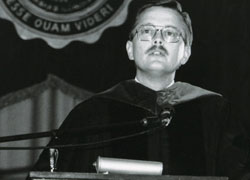Dr. James F. Winterstein will retire after 27 years as president of National University of Health Sciences on June 22nd, 2013, when he’ll take up the role of President Emeritus. As the fifth president of National, his many accomplishments changed history, expanded opportunities and raised educational standards for both the university and the chiropractic profession.
 After training as an X-ray technician in the Army, Winterstein entered the National College of Chiropractic as a DC student in 1964. Even while he was a student, he taught radiology at NCC. After his graduation, he was one of the first residents of NCC’s diagnostic imaging residency program, and eventually served as head of its radiology department.
After training as an X-ray technician in the Army, Winterstein entered the National College of Chiropractic as a DC student in 1964. Even while he was a student, he taught radiology at NCC. After his graduation, he was one of the first residents of NCC’s diagnostic imaging residency program, and eventually served as head of its radiology department.
Early in his career, he had a private practice in West Chicago, Illinois, and later in St. Petersburg, Florida, where he also had a successful X-ray reading service. During this time he was still active on NCC’s faculty, traveling across the country on weekends to teach post-graduate courses.
After serving for a year (1985) as NCC’s dean of clinics, Dr. Winterstein began his role as president of the institution on May 15th, in 1986. One of the most important achievements of President Winterstein’s presidency came in 1987 when he, along with the help of Dr. Emory Giles, successfully won recognition for National under the State of Illinois’ Health Services Education Grant, classifying it as a Class 1 medical school.
Under Winterstein’s leadership, National grew to be a leader in chiropractic research. Not only did National receive the first $1 million research grant from the Foundation for Chiropractic Research, since then it has received over $7.5 million in federal grants from the National Institutes of Health.
Although National had published the Journal of Manipulative and Physiological Therapeutics under Dr. Joseph Janse, Winterstein added two more scientific journals for the profession in the early nineties: the current Journal of Chiropractic Medicine and Journal of Chiropractic Humanities.
Through the years, Winterstein also served in several administrative capacities within the Council on Chiropractic Education,  working to raise admissions requirements and academic standards at all chiropractic institutions. Beginning in 1999 at NCC, applicants were required to complete a baccalaureate degree for admission. To date, National remains the only educational institution offering a chiropractic program to require this.
working to raise admissions requirements and academic standards at all chiropractic institutions. Beginning in 1999 at NCC, applicants were required to complete a baccalaureate degree for admission. To date, National remains the only educational institution offering a chiropractic program to require this.
In 2000, Winterstein succeeded in his vision to develop National into a campus devoted to integrative medicine, with multiple disciplines studying and working together. The National College of Chiropractic changed its structure, its charter and its name to become National University of Health Sciences. Over the next several years, its program offerings expanded to include professional degrees in naturopathic medicine, acupuncture and oriental medicine, masters degrees in diagnostic imaging and advanced clinical practice, and undergraduate degrees in massage therapy and biomedical science.
In 2009, under Winterstein’s leadership, NUHS opened a second campus in St. Petersburg, Florida in cooperation with the University Partnership Center of St. Petersburg College. NUHS also greatly expanded its number of hospital rotations and clerkships for professional degree students.
His successor, Joseph P. D. Stiefel, MS, EdD, DC, succinctly lauds Winterstein’s role in chiropractic history: “While the previous president, Dr. Joseph Janse, made the legitimizing of chiropractic education possible, it was Dr. James Winterstein who succeeded in legitimizing it.”
Winterstein remains the chiropractic profession’s most determined advocate for broad-scope primary care practice, as well as anchoring that practice in evidence-based medicine. As the fifth president of National, his legacy is an example of what can be achieved through uncompromising dedication to higher standards in both education and professional practice, and an unwavering commitment to patient-centered medical care.




0 Comments